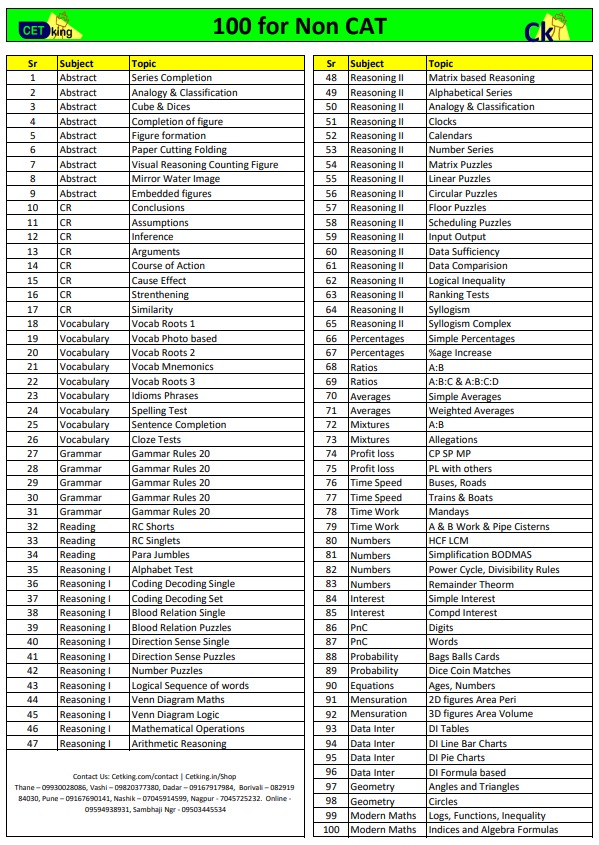
Abstract Reasoning in SNAP Exam
Abstract Reasoning tests your ability to identify patterns, logical rules, and trends in data. Key topics include:
- Series Completion: Identifying the next element in a sequence based on a pattern.
- Analogy & Classification: Finding relationships between different sets of items.
- Cube & Dices: Visualizing and solving problems related to 3D objects.
- Completion of Figure: Determining the missing part in an incomplete figure.
- Figure Formation: Forming a figure from given parts.
- Paper Cutting & Folding: Visualizing the results of paper folding and cutting.
- Visual Reasoning Counting Figure: Counting specific shapes in a complex figure.
- Mirror & Water Image: Identifying mirror or water-reflected images.
- Embedded Figures: Finding hidden figures within complex diagrams.
Critical Reasoning in SNAP Exam
Critical Reasoning evaluates your ability to analyze and interpret arguments. Essential topics include:
- Conclusions: Drawing logical conclusions from given statements.
- Assumptions: Identifying underlying assumptions in arguments.
- Inference: Deriving inferences from given data.
- Arguments: Analyzing and evaluating arguments.
- Course of Action: Suggesting appropriate actions based on given situations.
- Cause & Effect: Determining causal relationships between events.
- Strengthening: Identifying information that strengthens an argument.
- Similarity: Recognizing similarities between different sets of information.
Verbal Ability in SNAP Exam
Vocabulary: A strong vocabulary is crucial for verbal ability sections: Topics include
- Vocabulary Roots
- Photo-based Vocabulary
- Mnemonics
- Idioms & Phrases
- Spelling Test
- Sentence Completion
- Cloze tests
Grammar
Grammar forms the foundation of verbal ability. Focus on: Grammar Rules: Covering essential rules of grammar that frequently appear in exams.
Reading Comprehension
Reading Comprehension tests your ability to understand and interpret written text: Topics include RC Shorts, RC Singlets, and Para Jumbles.
Logical Reasoning in SNAP Exam
Logical reasoning is a vital area in competitive exams, testing your ability to analyze and solve problems efficiently. Key topics include Matrix-based Reasoning, Alphabetical Series, Analogy & Classification, Clocks, Calendars, and Number Series. Puzzles play a significant role, with types like Matrix Puzzles, Linear, Circular, Floor, and Scheduling Puzzles. Additional areas include Input-Output, Data Sufficiency, Data Comparison, Logical Inequality, Ranking Tests, and Syllogism (including complex forms). Mastery of these topics enables candidates to excel in reasoning sections, enhancing their overall performance in exams.
- Matrix-based Reasoning
- Alphabetical Series
- Analogy & Classification
- Clocks
- Calendars
- Number Series
- Matrix Puzzles
- Linear Puzzles
- Circular Puzzles
- Floor Puzzles
- Scheduling Puzzles
- Input-Output
- Data Sufficiency
- Data Comparison
- Logical Inequality
- Ranking Tests
- Syllogism
- Syllogism Complex
Quant Ability in SNAP Exam
The Quantitative Ability (QA) section in the SNAP exam is designed to assess a candidate’s mathematical skills and problem-solving abilities. This section covers a wide range of topics that are crucial for cracking the exam.
Percentages and Ratios form the foundation, with questions on simple percentages, percentage increases, and ratios involving multiple variables (e.g., A:B and A:B:C:D). Mastery of Averages, including both simple and weighted, is essential. Mixtures and Allegations focus on combining elements in specified ratios.
Profit and Loss questions test understanding of cost price, selling price, and market price. Time, Speed, and Work problems often involve scenarios like buses, trains, and boats, as well as work-related questions such as mandays and pipe cisterns.
In Number Systems, topics like HCF, LCM, BODMAS, and the Remainder Theorem are key. Interest calculations include both simple and compound interest.
Permutations and Combinations (PnC) and Probability are tested through problems involving digits, words, bags, balls, dice, and coins. Equations, Mensuration (2D and 3D), and Data Interpretation (DI) are also significant, with questions on DI tables, line, bar charts, and pie charts.
Finally, Geometry covers angles, triangles, and circles, while Modern Maths includes logs, functions, inequalities, and algebraic formulas. A strong grasp of these topics is essential for performing well in the SNAP QA section.





Leave a Reply